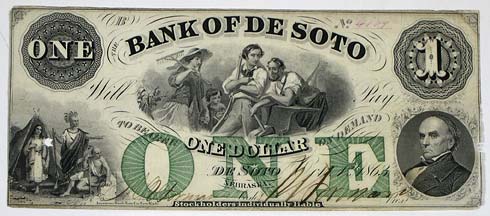
Science fiction and technology writer
Popular blog posts
Recent forum posts
Discussion Forum
Discussion forumShowing topics tagged as: Blockchain
How crypto stole from the poor and gave to the rich
Post #: 293
Post type: Blog post
Date: 2022-08-04 17:34:06.000
Author: Jeremy Reimer
Tags: crypto, blockchain

John Cleese playing Monty Python’s Dennis Moore, in a sketch where he discovers that the redistribution of wealth is harder than he thought.
The concept of digital money isn’t new. In fact, we all use digital money every day. The reason we can rely on numbers in a computer to safely represent our wealth is because we have laws that safeguard its handling, and centralized banks that must obey those laws.
This wasn’t always the case. In the mid-1800s, the US had no national banking system, and the metal coins issued by the government were awkward to use for large transactions. So wildcat banks appeared that made their own paper money, which they claimed was backed by real coinage. They were called “wildcat” because they built their branches far out in the wilderness, where cougars would prowl, to discourage people from visiting them to cash out. They lied about being backed by US silver coins, and printed as much fake money as they thought they could get away with. Eventually, the US government shut them down by issuing its own national paper currency, making the wildcat bank notes worthless.
An example of a wildcat bank note. Other wildcat banks included the Bank of Granite and the Bank of Singapore (the latter of which was based out of Michigan).
Cryptocurrency, which was invented back in 2008 following the collapse of the subprime mortgage market, was an attempt to separate digital money from banks. Lots of folks in the early 2000s had the idea to make “digital bucks” or “eCoins” of some kind. But the problem was this: if you weren’t attached to a real bank, how could you prevent someone from just “copy/pasting” their eCoins over and over again, gaining infinite wealth? If you didn’t want to trust a central authority and a central government, how could you make this work?
The solution was called Bitcoin. It worked like this: all transactions would be added to a public “digital ledger” that anyone could read, but that could never be changed. After all, if you could edit your transaction after the fact, you could easily “copy/paste” coins to yourself by refunding your own purchase. The Bitcoin algorithm reserved all the coins that would ever exist, then required “miners” to compete to solve ever-more challenging math problems. The first person or group to solve them would be awarded one Bitcoin, and then everyone on the network would have to verify that the solution was correct. In a similar way, every movement of Bitcoins from one digital “wallet” to another had to be approved and added to the ever-growing ledger, which was called a “blockchain”.
This trust-free solution was ridiculously inefficient, but it didn’t matter at first, because so few people bothered to use it. In the early days, it was relatively easy to mine new Bitcoins. But there wasn’t much you could do with them, because there was no connection with banks or with real money. In 2010, one of the first “purchases” made with Bitcoin involved one user transferring 10,000 Bitcoins to another user. Then the person who received them went and ordered pizza for the first person. This infamous 10K Bitcoin pizza is used as a cautionary tale to warn people to hold on to their Bitcoins, because the low price per Bitcoin back then has since skyrocketed, reaching a maximum value of $70,000. Haha, it’s the world’s most expensive pizza!
These were the actual pizzas bought for 10,000 Bitcoins in 2010. Today, if you had 10,000 Bitcoins, you’d have a hard time finding enough people with enough money to sell them to for the dollar value they claim to represent.
Except it wasn’t, really. Bitcoin was just a plaything for nerds back then, which is why the “price” per coin was so low. To cash out your Bitcoins, you had to send them to someone first, then hope they would pay you back in real dollars at an agreed-upon price. This was awkward and involved a lot of trust, the very same trust that crypto was supposed be avoiding in the first place.
To get around this problem, crypto fans invented “exchanges”. The idea was that people would log on to the exchange and the website would automatically connect buyers and sellers, similar to stock trading websites.
Agreeing on a price, however, was still difficult. As larger organizations started to buy and sell big piles of Bitcoin, the price would fluctuate wildly. By the time the transaction completed (which took a while, because of the inefficient nature of cryptocurrency itself) the price might be completely different.
The solution to this was called the “stablecoin”. To obtain one, you gave a real US dollar to one of the exchanges (every exchange had their own coin, for reasons we’ll see later). They gave you back a digital token that everyone agreed would always be worth exactly one dollar. You could easily exchange this stablecoin for Bitcoin or any of thousands of other copycat crypto coins. Then, if the price of your coins went down, you’d just hold on to them. If the price went up, you could convert them back to stablecoins, and then in theory, the exchange could swap them again for the same amount of real money. In theory. After all, the exchanges would always have a big pile of real dollars that people gave them for the stablecoins in the first place, right? Right?
Unfortunately, none of this was regulated, so there was nothing stopping the exchanges from printing as many new stablecoins as they could get away with, backed by exactly nothing, while claiming that they were fully backed.
Stop me if this sounds familiar.
These “exchanges” had now become 21st century digital wildcat banks, who could create their own fake currency out of nothing, charge people real money to buy it, and then make it really really hard to swap it back. They could then "buy" Bitcoins with these fake stablecoins, which would drive up the price of Bitcoin.
Some of these wildcat banks, like Celsius and Voyager, took the idea even further. They realized that most people never managed to cash out their crypto coins, but just held on to them forever. With the promise of Ponzi-level interest rates as high as 18 percent, they lured new customers in. To get these high rates of return, these crypto banks would first take ownership of the user’s coins, then lend them out to other crypto banks who were doing the same thing. The highest interest rates (up to 20 percent!) were offered by an organization that had its own “algorithmic” stablecoin called “Terra”, that didn’t even pretend to be backed by real money at all. It was backed only by another crypto coin called “Luna”.
The founder of Celsius, who liked to wear a shirt that said “Banks are not your friends” while running a crypto-based bank that stole everyone’s money.
None of this made any sense mathematically, and when the price of Luna suddenly dropped to zero, the entire house of cards fell over. Three Arrows Capital, which had a big investment in Terra/Luna, declared bankruptcy and the owners fled to Dubai. Celsius and Voyager, which had big investments in Three Arrows Capital, then declared bankruptcy a month later.
Most of the money lost was from small investors, some of whom had put their life savings into Celsius, Voyager, or similar companies. Many of these people were poor, and many were living in poor countries. Crypto was sold to these people as a way for them to beat the system, to make real wealth when there were no other opportunities.
The collapse of the digital wildcat banks wasn’t the only loss for small investors, however. The peak of crypto advertising happened in late 2021, with a barrage of celebrity endorsements, Super Bowl ads, and even renaming of sports stadiums.
This push was deliberate, and calculated. Millions of people who knew nothing about crypto were convinced that this was the “next big thing” and that they should get in while the getting was good. Bitcoin’s price peaked at $70,000 during this time. The trading was mostly one-way: groups of rich investors selling their Bitcoins in little pieces to poor individuals who were about to become much poorer. The price of Bitcoin then collapsed to around $20,000, where it remains today.
Yes, Matt Damon, fortune can favor the brave. But it usually favors rich men who know how to convince poor people to give them money.
Let’s be clear: there were definitely people who made money with crypto. These people were rich bankers who paid themselves millions of dollars to run the exchanges, and sold as many of their own tokens (that they created out of thin air for free) as they could get away with, while they manipulated the market in their favor. And because of the irreversible nature of the blockchain, these transactions can never be rolled back. Thieves and hackers have also used this "feature" of crypto to their advantage.
Some of these folks are now on the run from the law, but most aren’t. They claim to have just been running a business, and take no responsibility for their actions. Some have bought mansions worth over a hundred million dollars. The Three Arrows Capital guys put a fifty million dollar downpayment on a yacht just before they fled the country.
As we enter what the industry is calling a “crypto winter”, these companies are laying off workers, cancelling big projects, or just going bankrupt. But their leaders all insist that crypto currencies are still inevitable and are still the future, even though they can’t quite articulate how. They assume that the price of crypto coins will eventually go back up, that the celebrities and Super Bowl ads will return, and they will once again be free to steal from the poor and give to the rich.
And they might, unless the public decides that enough is enough.
Views: 6296
So who am I?
I'm a writer and programmer. I write science fiction stories and novels.
I am the writer for the upcoming documentary series Arcade Dreams.
I also write technology articles for Ars Technica.
I'm the creator of newLISP on Rockets, a web development framework and blog application.
- Email: jeremy.reimer@gmail.com
Topics
3D Modeling
About Me
Amiga
Articles
Audio
Blockchain
Blog
Blogs
Book Reviews
Book review
Comics
Computer history
Computers
Computers Microhistory
Computing
Conventions
Crypto
Daily update
Entrepreneur
Family
Forum post
Gaming
Gaming Starcraft
Gaming metaverse
Internet
Jeremy Birthday
Keats
Kickstarter
Knotty Geeks
Knotty Geeks (video)
Market Share
Masters Trilogy
Monarch
Movies
My Non-Fiction
My Science Fiction
NewLISP Blog
Novels
OSY
Operating Systems
Pets
Poll
Reviews
Science Fiction
Servers
Software
Software Operating Systems
Space
Star Gamer
Star Trek
Starcraft
Television
Testing
Toys Childhood
Valheim
Wedding Marriage
Work
Work Life
World
Writing
 RSS Feed for this blog
RSS Feed for this blog